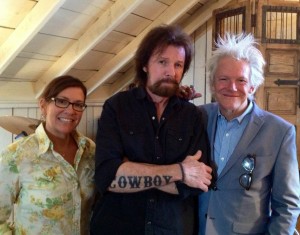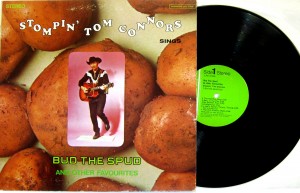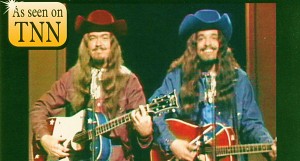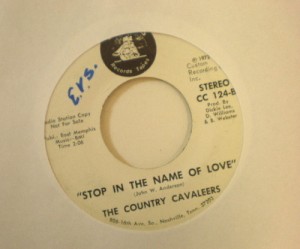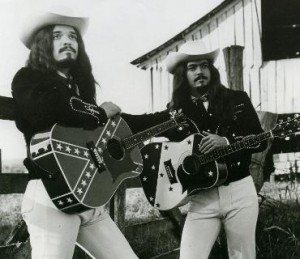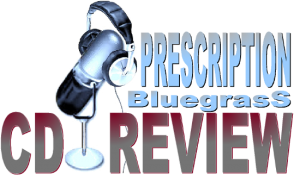JasonR
 Coming Monday July 15th, 2013
Coming Monday July 15th, 2013
– An insider exclusive, Raw and Uncut! –
“The complete life story of Sheila Raye Charles”
( the daughter of music legend Ray Charles )
– brought to you by MusicChartsMagazine.com
MusicChartsMagazine.com – brings to you all-access passes to music around the world. It is, has been, and will continue to be, a mission of Music Charts Magazine to shed light on those whom have had lifelong careers in the music industry and deserve recognition for their great accomplishments.
 Lead Single from Iconic Male Country Vocalist’s Forthcoming 2013 Album
Lead Single from Iconic Male Country Vocalist’s Forthcoming 2013 Album
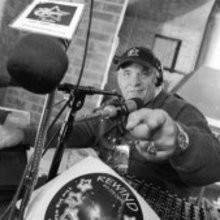 DJ Jimmy Jay’s radio “Rewind Show” – ( Remembering the life of Marshall Lytle – PART 2 – band member of Rock n Roll’s 1st, Bill Haley and The Comets ) at MusicChartsMagazine.com
DJ Jimmy Jay’s radio “Rewind Show” – ( Remembering the life of Marshall Lytle – PART 2 – band member of Rock n Roll’s 1st, Bill Haley and The Comets ) at MusicChartsMagazine.com
Go through time with legendary DJ Jimmy Jay “Rewind” as he speaks with multiple celebrities in this special radio show remembering the great Marshall Lytle. Including special guest appearances from James Marvell of Mercy, Al Jardine of The Beach Boys, Paul Revere of The Raiders, Charlie Thomas of The Drifters, Diamond Dave Summerville of The Diamonds and so many more celebrity names we all know and love.
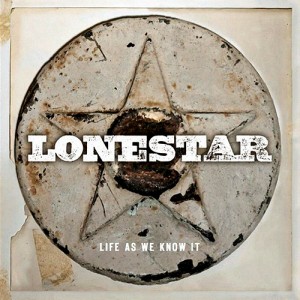 It has been more than 20 years since Lonestar released “Amazed,” and landed in the No. 1 position on country music charts for 16 consecutive weeks. Since then, Richie McDonald left the group to work on a few solo projects . Richie has returned to the band, and is part of the new album “Life As We Know It,” which released on June 4.
It has been more than 20 years since Lonestar released “Amazed,” and landed in the No. 1 position on country music charts for 16 consecutive weeks. Since then, Richie McDonald left the group to work on a few solo projects . Richie has returned to the band, and is part of the new album “Life As We Know It,” which released on June 4.
I don’t think anyone can hear the name Lonestar without remembering their hit song “Amazed.” And, while that song definitely brought them the most success, it was not their only number one hit. “Smile,” ”Come Cryin’ to Me,” “No News, ” “What About Now,” “Tell Her,” “I’m Already there,” “My Front Porch Looking In,” and “Mr. Mom” all took their turn at the top spot.
Back to its original four members, with Richie McDonald, Dean Sams, Keech Rainwater and Michael Britt, have put together this new album that showcase Lonestar’s talent, both as a band and as songwriters.
The band wrote all but three songs on this album, that gives us The Countdown, Maybe Someday, How Can She Be Everywhere, Pretty Good Day, With My Eyes Open, Party All Day, Life as We Know It, If It Wasn’t for You, I Miss When, I Did it for the Girl, Just the Rain, and Oh Yeah.
Music titles can sometimes confuse the listener. This isn’t the first time “Life As We Know It” has been on the cover of an album. The last time, it was on vinyl, and the album was by REO Speedwagon. That was back in 1987. More recently Greg Bates did a country song called “Did It For The Girl,” and Lonestar has a song on this album with almost the same title, “I Did It For The Girl.”
I wasn’t really impressed with the title track, “Life As We Know It,” and I can’t imagine that one doing very well if released as a single. “Countdown,” the first song on the album, is a good song, and I’m not surprised they put that in the lead-off position.
I only had to listen to the album once to pick a favorite song. For me, “Just the Rain” was the one I wanted to hear again and again. It reminds me of Lonestar 20 years ago. Those of us who were fans then will remain fans, as long as the group keeps putting out this kind of music. It’s a slow, emotional song, well sung, and allows the band to showcase the harmony they’ve always been known for.
As much as I like “Just the Rain,” I’m not sure that one will do well as a single. But there are some that will. I think a great single for this group would be “How Can She Be Everywhere.” Radio might also enjoy sharing songs like “If It Wasn’t For You” and “I Miss When,” with listeners. “Pretty Good Day” is another one that I would imagine people will call and request if it is released as a single. It is an uptempo, feel good song.
The whole album is good, and I think the ballads are the best. “I Miss When,” “Just Rain” and “Maybe Someday” are great songs. But, in today’s Top 40 country market, if those ballads were released to radio, I’m not sure they would get the air time some of the faster songs would.
Keep up with Lonestar by visiting their website, www.lonestarnow.com. Follow them on Twitter @lonestarband. To find out everything going on in country music, visit www.countryschatter.com, and follow us on Twitter @countryschatter.
Music Charts Magazine History
– Song for the month of July 2013:
Stompin’ Tom Connors – “Bud The Spud“
Listen to Stompin’ Tom Connors song “Bud The Spud” here:
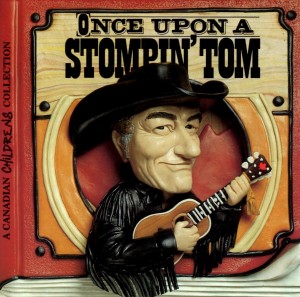 Thomas Charles “Stompin’ Tom” Connors, OC (February 9, 1936 – March 6, 2013) was one of Canada’s most prolific and well-known country and folk singer-songwriters. Focusing his career exclusively on his native Canada, Connors is credited with writing more than 300 songs and has released four dozen albums, with total sales of nearly 4 million copies. Connors died at age 77 in his home in Ballinafad, Ontario.
Thomas Charles “Stompin’ Tom” Connors, OC (February 9, 1936 – March 6, 2013) was one of Canada’s most prolific and well-known country and folk singer-songwriters. Focusing his career exclusively on his native Canada, Connors is credited with writing more than 300 songs and has released four dozen albums, with total sales of nearly 4 million copies. Connors died at age 77 in his home in Ballinafad, Ontario.
His songs have become part of the Canadian cultural landscape. Three of his best-known songs — Sudbury Saturday Night, Bud the Spud and The Hockey Song — play at every home game of the Toronto Maple Leafs hockey team. The Hockey Song is played at games throughout the National Hockey League.
He was born Charles Thomas Connors in Saint John, New Brunswick to the teenaged Isabel Connors and her boyfriend Thomas Joseph Sullivan at midnight February 9, 1936 at the General Hospital in Saint John, New Brunswick. Isabel’s family were Protestant, and his maternal grandfather, John Connors was a sea captain from Boston, Massachusetts who had died before Stompin’ Tom was born. Stompin’ Tom’s father was a Catholic of Irish and French ancestry, and “may have been Métis or … Micmac.” Isabel Connors and Thomas Joseph Sullivan didn’t wed until 30 years later, probably because Sullivan’s family were devout Catholics and didn’t want him marrying a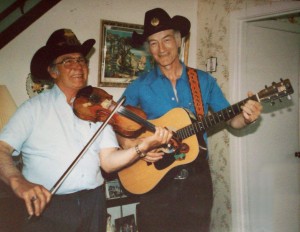 Protestant; they later divorced. Sullivan’s mother gave him $10, and was told to leave home. Connors was also cousin of New Brunswick fiddling sensation, Ned Landry.
Protestant; they later divorced. Sullivan’s mother gave him $10, and was told to leave home. Connors was also cousin of New Brunswick fiddling sensation, Ned Landry.
Connors spent a short time living with his mother in a low-security women’s penitentiary before he was seized by Children’s Aid Society and was later adopted by Cora and Russell Aylward in Skinners Pond, Prince Edward Island.
At the age of 15 he left his adoptive family to hitchhike across Canada, a journey that consumed the next 13 years of his life as he travelled between various part-time jobs while writing songs on his guitar, literally singing for his supper. He worked in the mines and rode in boxcars, and, in the coldest part of winter, he welcomed vagrancy arrests in order to have a warm place to sleep. At his last stop in Timmins, Ontario, which may also have been his big “break”, he found himself a nickel short of a beer at the city’s Maple Leaf Hotel. The bartender, Gaëtan Lepine, agreed to give Tom a beer if he would play a few songs. These few songs turned into a 13-month contract to play at 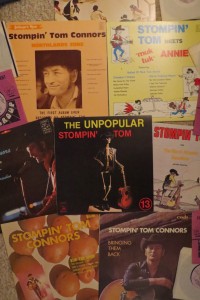 the hotel, a weekly spot on CKGB in Timmins, eight 45-RPM recordings, and the end of the beginning for Tom Connors.
the hotel, a weekly spot on CKGB in Timmins, eight 45-RPM recordings, and the end of the beginning for Tom Connors.
Connors’ marriage to Lena Welsh took place on November 2, 1973, being broadcast live on Elwood Glover’s Luncheon Date on CBC Television. They chose to get married on television in order, he said during an interview on the show, to share the happiest moment with his fans across the country, whose support had rescued him from a difficult life before show business.
Connors was never part of the Canadian musical establishment, and his style was quite different from other Canadian icons such as Leonard Cohen or Gordon Lightfoot. He could, however, be characterized as a passionist poet within Canadian culture, similar to Milton Acorn and Stan Rogers.
Typically writing about Canadian lore and history, some of Connors’ better-known songs include “Bud the Spud”, “Big Joe Mufferaw”, “The Black Donnellys”, “The Martin Hartwell Story”, “Reesor Crossing Tragedy”, “Sudbury Saturday Night” and “The Hockey Song” (often incorrectly referred to as “The Good Old Hockey Game”); the last is frequently played over sound systems at National Hockey League (NHL) games.
Connors’ habit of stomping the heel of his left boot to keep rhythm earned him the nickname “that stompin’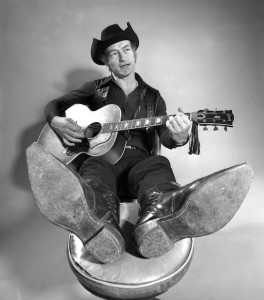 guy”, or “Stomper”. It wasn’t until Canada’s 100th birthday, July 1, 1967, that the name “Stompin” Tom Connors was first used, when Boyd MacDonald, a waiter at the King George Tavern in Peterborough, Ontario introduced Tom on stage. Based on an enthused audience reaction to it, Tom had it officially registered in Ontario as Stompin’ Tom Ltd. the following week. Various
guy”, or “Stomper”. It wasn’t until Canada’s 100th birthday, July 1, 1967, that the name “Stompin” Tom Connors was first used, when Boyd MacDonald, a waiter at the King George Tavern in Peterborough, Ontario introduced Tom on stage. Based on an enthused audience reaction to it, Tom had it officially registered in Ontario as Stompin’ Tom Ltd. the following week. Various 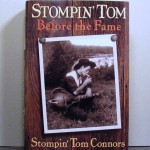 stories have circulated about the origin of the foot stomping, but it’s generally accepted that he did this to keep a strong tempo for his guitar playing — especially in the noisy bars and beer joints where he frequently performed. After numerous complaints about damaged stage floors, Tom began to carry a piece of plywood that he stomped even more vigorously than before. The “stompin’ “ board has since become one of his trademarks. After stomping a hole in the wood, he would pick it up and show it to the audience (accompanied by a joke about the quality of the local lumber) before calling for a new one. It was reported that when asked about his “stompin’ board”, Tom replied, “it’s just a stage I’m going through”. Stompin’ Tom periodically auctioned off his “stompin’ boards” for charity, with one board selling for $15,000 in July, 2011.
stories have circulated about the origin of the foot stomping, but it’s generally accepted that he did this to keep a strong tempo for his guitar playing — especially in the noisy bars and beer joints where he frequently performed. After numerous complaints about damaged stage floors, Tom began to carry a piece of plywood that he stomped even more vigorously than before. The “stompin’ “ board has since become one of his trademarks. After stomping a hole in the wood, he would pick it up and show it to the audience (accompanied by a joke about the quality of the local lumber) before calling for a new one. It was reported that when asked about his “stompin’ board”, Tom replied, “it’s just a stage I’m going through”. Stompin’ Tom periodically auctioned off his “stompin’ boards” for charity, with one board selling for $15,000 in July, 2011.
Connors always wore his black Stetson in public, and refused to remove it for any reason, even when meeting Queen 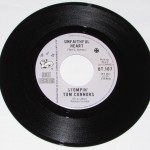 Elizabeth II at a dinner in Ottawa in October 2002. Buckingham Palace smoothed the way by likening Mr. Connors’s hat to a religious headdress such as a nun’s habit or a Sikh’s turban.
Elizabeth II at a dinner in Ottawa in October 2002. Buckingham Palace smoothed the way by likening Mr. Connors’s hat to a religious headdress such as a nun’s habit or a Sikh’s turban.
From the Juno Awards, Country Male Vocalist of the Year (1971–1975) and Country Album of the Year (1974, for To It And At It) — all subsequently returned in 1978. He left instructions that the Junos were not to celebrate him after his death.
In 2009, a SOCAN award for Lifetime Achievement.
In 1993, he declined to be inducted into the Canadian Country Music Hall of Fame.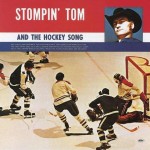
In The Greatest Canadian list, Stompin’ Tom Connors ranked thirteenth, the highest placing for any artist on the list. Connors was one of four musicians pictured on the second series of the Canadian Recording Artist Series issued by Canada Post stamps on July 2, 2009.
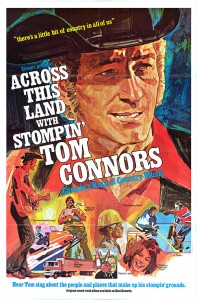 Connors’ music is rarely heard outside Canada, with the possible exception of his anthemic The Hockey Song which has been recorded by many artists. It has been suggested that Connors refused to allow foreign release of his material, although a more likely reason is that the very Canadian-specific subject matter of many of his folk songs has resulted in limited demand in foreign markets. When Late Night with Conan O’Brien taped a week’s worth of shows in Canada in 2004, Connors was one of the guests of honor, leading the Toronto audience in a rendition of “The Hockey Song”; this was one of the few times Connors performed on American television.
Connors’ music is rarely heard outside Canada, with the possible exception of his anthemic The Hockey Song which has been recorded by many artists. It has been suggested that Connors refused to allow foreign release of his material, although a more likely reason is that the very Canadian-specific subject matter of many of his folk songs has resulted in limited demand in foreign markets. When Late Night with Conan O’Brien taped a week’s worth of shows in Canada in 2004, Connors was one of the guests of honor, leading the Toronto audience in a rendition of “The Hockey Song”; this was one of the few times Connors performed on American television. Another Canadian-taped installment of Late Night featured a segment in which Triumph the Insult Comic Dog visited Quebec; a parody of Connors’ “Canada Day, Up Canada Way” is heard during the segment.
Another Canadian-taped installment of Late Night featured a segment in which Triumph the Insult Comic Dog visited Quebec; a parody of Connors’ “Canada Day, Up Canada Way” is heard during the segment.
His character was rough but genuine.
Stompin’ Tom Connors was to Canada what Johnny Cash was to the United States. Stompin’ Tom Connors is known as the Canadian Troubadour of Folk and Country Music.
Read more at: http://en.wikipedia.org/wiki/Stompin’_Tom
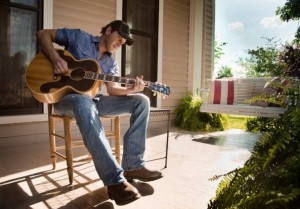 JEKYLL ISLAND, Ga. – (Monday, July 1, 2013) Enjoy a weekend of music, food and fun on Jekyll Island this August for Rodney Atkins’ America’s Heroes Celebration Weekend. Dedicated to the brave men and women who serve in our nation’s military, this weekend celebration will bring together families and friends for several exciting events including a spotlight for one of the biggest names in country music.
JEKYLL ISLAND, Ga. – (Monday, July 1, 2013) Enjoy a weekend of music, food and fun on Jekyll Island this August for Rodney Atkins’ America’s Heroes Celebration Weekend. Dedicated to the brave men and women who serve in our nation’s military, this weekend celebration will bring together families and friends for several exciting events including a spotlight for one of the biggest names in country music.
James Marvell and Buddy Good.
The band – “The Country Cavaleers”
Click the red play button below to listen to a Music Charts Magazine Celebrity Interview with:
“James Marvell” of “The Country Cavaleers”:
Long hair, an anti-drug message, two well-known guys in the music industry, and the decade is the 70’s. Who would have thought that two young men by the names of James Marvell and Buddy Good would 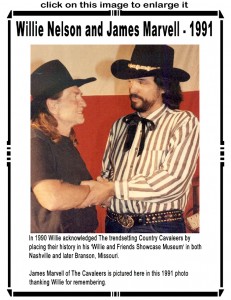 became the original outlaws of country music?
became the original outlaws of country music?
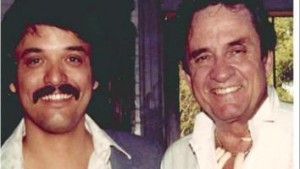 James Marvell and Buddy Good appeared in concerts with Dolly Parton, Conway Twitty, Freddy Fender, Loretta Lynn, Jack Green, Johnny Cash and multiple other country music legends. Country Cavaleer’s early recordings were on Cutlas and CSA Records. Later, the duo was picked up by MGM Records.
James Marvell and Buddy Good appeared in concerts with Dolly Parton, Conway Twitty, Freddy Fender, Loretta Lynn, Jack Green, Johnny Cash and multiple other country music legends. Country Cavaleer’s early recordings were on Cutlas and CSA Records. Later, the duo was picked up by MGM Records.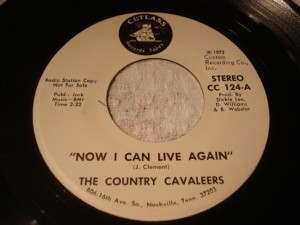
James Marvell sang lead and Buddy Good sang harmony. Both James and Buddy played acoustic guitars that were given to them by Grand Ole Opry Legend Billy Grammer. During their career, Hank Williams Sr.’s band “The Original Drifting Cowboys”, with Jerry Rivers on the fiddle, backed up some of The Country Cavaleer’s concerts.
How they got there:
James Marvell and Buddy Good started out as a garage band in the 60’s and ended up as the band calling themselves “The Skopes”. The Skopes were on USA Records, the same record label as the well-known band “The Buckinghams”. “The Skopes” had a big song written by their manager John Centinaro and James Marvell titled 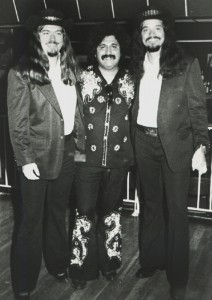 “She’s Got Bad Breath” which was a success as well as the demise of the group since a mouth rinse company with a similar name put a stop to it.
“She’s Got Bad Breath” which was a success as well as the demise of the group since a mouth rinse company with a similar name put a stop to it.
From there, James Marvell and Buddy Good joined the mega hit band “Mercy” which not long afterwards skyrocketed up the charts in Billboard, Cash Box and Record World Magazine to number 2 with the million seller hit song “Love Can Make You Happy”. “Love Can Make You Happy” was written by Jack Sigler Jr. and became the number 2 song under “The Beatles” number 1 song “Get Back”. The year was 1969.
After leaving the band Mercy in 1970 James Marvell and Buddy Good went on to become known by many as the original country music outlaws, a decade ahead of their time. An unlikely duo who’s odds were not high had a 3rd time success come to them as their new band “Country Cavaleers” was formed.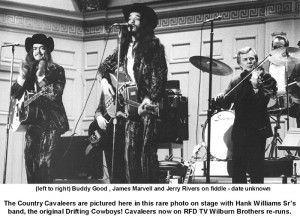
Country Cavaleers were known for their turntable hits singing songs throughout the 70’s like the “Stop In The Name Of Love”, the 1973 hit song “Humming Bird “and the 1976 hit song “Te Quiero (I Love You in Many Ways)” which were both charting songs. Some other Country Cavaleer songs you may know or may have forgotten are “Sweet Yesterdays“, “I’ve Got My Mind Satisfied“, “Everett The Evergreen“, “Call Back Operator” and the Jack Clement original “Now I Can Live Again.”
The Country Cavaleers sang and played guitar on the Wilburn Brothers TV program in the 70’s which is currently in reruns on RFDTV.
James Marvell, former lead singer of the duo, is still at it today. He recently won two rounds of The Texaco Country Showdown this 2013. What will James do next? It’s hard to tell. One thing is for sure. James Marvell has lived and is part of country music history.
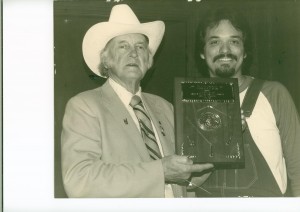
The Father of Bluegrass Bill Monroe and James Marvell of the “original country outlaws” the 70’s band “Country Cavaleers” – James Marvell – Music Charts Magazine Celebrity Interview with James Marvell of The Country Cavaleers





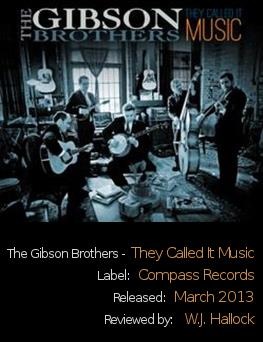 I knew it at the time…… I thought about it while I was listening to this CD….. I’m thinking about it right NOW, and getting madder by the minute!!!
I knew it at the time…… I thought about it while I was listening to this CD….. I’m thinking about it right NOW, and getting madder by the minute!!!
Eric and Leigh Gibson were about two hours away from my home doing a show at Byron Berline’s Double-Stop-Fiddle-Shop Theater in Guthrie, OK last year….and I missed it! I’ve been kickin’ myself ever since! Byron’s theater is intimate, warm and diligently refined for acoustic music. In other words, the perfect place to have seen the 2012 IBMA Entertainer’s Of The Year. And I MISSED IT!
I guarantee that won’t happen again…..
“They Called It Music,” their third, and latest release on Compass Records, was recorded at Compass Studios in December, 2012. Eric, Leigh and the “third Gibson Brother,” Mike Barber, their twenty year veteran bass player, produced it with noted engineer Ben Surratt behind the recording board. In 2011, The Gibson’s CD, “Help My Brother,” was the IBMA Album Of The Year, and there’s absolutely no reason why this CD shouldn’t be in the running for that title again.
With Eric on banjo and guitar, Leigh on guitar and Mike on upright bass, they are joined by long time band mates Clayton Campbell on fiddle and Joe Walsh on mandolin. According to Eric, the title song had been worked out and stage tested, but the rest were recorded with minimal rehearsal time. You’d sure never know it by listening! The band grabbed on to these songs and just took off! All the years of being on stage together have seasoned this unit and given them each a sixth sense for how the others are going to jump, move and sway to the rhythm of each song. The dual strength of Eric and Leigh form a middle ground that Mike’s bass just has to add propulsion to, and Clayton’s fiddle and Joe’s mandolin are like hornets darting in and out of the songs stinging your ears with solos and fills.
This recording really shows off the best side of each player, and “Engineer Ben” caught it all in the studio. While working on this review, the band’s press agent released the news that Joe Walsh would be leaving the band to follow another path, and in an e-mail to me from Eric, they wished him well and praised his work on this CD. Although Eric and Leigh have not named a replacement at this time, when the right one comes along, I’m sure he’ll be the “pick of the litter!” New members usually bring vitality, energy and new perspectives, so I fully expect the next incarnation of The Gibson Brother’s Band to be even better than this one.
An even dozen songs are the result of last December’s sessions. Six are originals, and the other six are by such well known and noted writers as Loretta Lynn and Shawn Camp, Joe Newberry, Mark Knopfler, Austin Taylor, Roy Hurd and Elizabeth Hill, and J.L. Frank and PeeWee King. Each one is distinct and interesting in it’s own way. Knopfler’s “Daddy’s Gone To Knoxville” is a favorite. “Home On The River,” by Austin Taylor, dating back to 1913, shows just how superb Eric and Leigh carry the gospel message musically. Their duet on this one is zealous and contagious. You’ll be wanting to sing and clap along from the front pew!
Read the rest of this review at the Prescription Bluegrass’ website by clicking the red link:
Music Charts Magazine Bluegrass Album and Artist Reviews are in co-operation with PrescriptionBluegrass.blogspot.com
Unique Summer Program Brings Together Youth With Outstanding Artists And Music Industry Professionals
SANTA MONICA, Calif. (June 25, 2013) — The GRAMMY Foundation® (www.grammyfoundation.org) announced today that 99 talented high school students from 87 U.S. cities and 27 U.S. states have been selected as participants in the ninth annual GRAMMY Camp® program. In addition, through a partnership with GUCCI, four international students from Japan and England will attend GRAMMY Camp in Los Angeles, bringing the total number of students to 103 this year. The Foundation’s signature music industry camp for U.S. high school students will be held in Los Angeles from July 13–22 at the University of Southern California Thornton School of Music and in New York from Aug. 4–12 at Converse Rubber Tracks. This GRAMMY in the Schools® program is supported in part by Converse. “When we started this GRAMMY in the Schools® program nine years ago, we had very high hopes and aspirations for GRAMMY Camp ” said Neil Portnow, President/CEO of The Recording Academy® and the GRAMMY Foundation. “And I can truly say we’ve met our goals to offer young people a hands-on experience that delivers a sense of what it’s like to have an actual career in the music industry. Teens spend their time at GRAMMY Camp working with GRAMMY®-winning artists and industry professionals gaining knowledge and sharpening their skills, so they will be ready to take the next steps in their careers.” Applications for GRAMMY Camp 2014 are currently online at www.grammyintheschools.com and the deadline is March 31, 2014. Financial aid is available and approximately 70 percent of GRAMMY Camp participants who have applied for financial aid have received assistance. “Almost every artist and music professional who we bring to GRAMMY Camp comes away saying two things — ‘These kids are so talented’ and ‘I wish I’d had this kind of experience when I was young,'” said Kristen Madsen, Sr. Vice President of the GRAMMY Foundation. “This underscores the collaborative and immersive nature of GRAMMY Camp, and the fact that the experience produces lasting effects and positive influences for the campers who participate each summer.”
GRAMMY Camp L.A.: July 13–22 The program offers selected high school students an interactive 10-day residential summer music experience. Focusing on all aspects of commercial music, this unique opportunity provides instruction by industry professionals in an immersive creative environment with cutting-edge technology in professional facilities. The program offers six music career tracks: Engineering for Audio & Video; Electronic Music Production; Multimedia; Music Business; Songwriting; and a performance track for bass, drums, guitar, keyboard, vocal, and winds & strings. All tracks culminate in media projects, CD recordings and/or performances. GRAMMY Camp L.A. will be held at the University of Southern California Thornton School of Music and other professional venues throughout Los Angeles. 2013 GRAMMY Camp Los Angeles Selectees and Tracks
Zoe Adler Long Beach, Calif. Multimedia
Kelsey Alexander Orange Beach, Ala. Music Business
Wes Anderson Oneida, Ill. Bass
Houston Averiett II Missouri City, Texas Audio Engineering
Hudson Barineau Houston Guitar
Kellcee Batchelor Tarboro, N.C.
Music Business Colby Benson Mililani, Hawaii Songwriting
Harun Bonnett Brooklyn, N.Y. Drums
Haleigh Bowers Chino Hills, Calif. Songwriting
Conner Broome Henderson, Tenn. Keys
Rachel Brothers Palos Verdes Estates, Calif. Songwriting
Patrick Bucknor Los Angeles Electronic Music Production
Isaiah Carter Lee’s Summit, Mo. Drums
Ryan Casey Glen Allen, Va. Guitar
Ben Cohen Columbia, Md. Electronic Music Production
Elizabeth Cohen Los Angeles Music Business
Zoe Concha Beverly Hills, Calif. Vocal
Carter Couron San Diego Drums
Cael Dadian Poway, Calif. Vocal
Daniel Davila Encino, Calif. Music Business
Mark Diaz San Fernando, Calif. Bass
Shelby Dibs Howard Beach, N.Y. Music Business
Isaac Duribe London, England Electronic Music Production
Sabrina Elam Baltimore Songwriting
Hayley Emerson Beverly Hills, Calif. Multimedia
Brendan Eprile Bennington, Vt. Vocal
Jacob Feldman Tarzana, Calif. Electronic Music Production
Jennifer Firestone Chesterfield, Mo. Music Business
Sophia Forino Corona del Mar, Calif. Music Business
Dane Foster Los Angeles Multimedia
Yasamin Ghodsbin Newport Beach, Calif. Audio Engineering
Wyatt Giampa Portola Valley, Calif. Audio Engineering
Zach Gospe Los Altos, Calif. Songwriting
Alecia Greene Atlanta Multimedia
Rita Guzman Decorah, Iowa Music Business
Raina Henderson Closter, N.J. Electronic Music Production
Seth Irby San Diego Bass
Nasya Jeffers Owings Mills, Md. Vocal
Noah Kovalick Newbury Park, Calif. Audio Engineering
Mikey LaSusa Eagan, Minn. Guitar
Devon Lawrence Mill Valley, Calif. Songwriting
Anh Le Madison, Wis. Songwriting
David Li Chandler, Ariz. Keys
Danielle Lowe Los Angeles Multimedia
Wyatt Lowe San Marcos, Calif. Guitar
Kennedi Lykken Spicer, Minn. Songwriting
Graham Marsh Houston Audio Engineering
Jacob McCoy Nashville Audio Engineering
Jonathan McCoy Wyncote, Pa. Electronic Music Production
Evan Mehta Burbank, Calif. Keys
Christine Meisenhelter Aberdeen, N.J. Bass
Devan Monroe Pearland, Texas Drums
Autumn Myers Howell, N.J. Music Business
Takumi Nakayama Shizuoka, Japan Winds/Strings/Horns
Tanya Orlov Redondo Beach, Calif. Audio Engineering
Pavlina Osta Port Orange, Fla. Multimedia
Quinn Oulton London, England Winds/Strings/Horns
Ross Phillips Indianapolis, Ind. Electronic Music Production
Jason Saitta Chantilly, Va. Songwriting
Tafari Salaam Beaufort, S.C. Winds/Strings/Horns
Dorian Sanders Maryland Heights, Mo. Guitar
Ryota Sasaguri Kagawa, Japan Winds/Strings/Horns
Julian Scanlan Mount Laurel, N.J.
Electronic Music Production Drew Schwendiman Summit, N.J. Multimedia
Jahmori Simmons Douglasville, Ga. Electronic Music Production
Aaron Spieldenner Normandy Park, Wash. Audio Engineering
Dominic Spitaliere Huntersville, N.C. Electronic Music Production
Tyler Talmadge Albuquerque, N.M.
Electronic Music Production Chloe Tang Phoenix Songwriting
Camille Thornton Great Falls, Va. Songwriting
Lilliana Villines Van Nuys, Calif. Songwriting
Chase Walker Riverside, Calif. Guitar
Marcus Wanner Nashville Guitar
Maxwell Yi Houston Electronic Music Production
GRAMMY Camp N.Y.: Aug. 4–12, 2013 GRAMMY Camp N.Y. is a nine-day residential program for high school students that offer campers the opportunity to work in integrated industry teams. This real-world, hands-on environment will involve an in-depth look at the entire creative process from the first spark of original material through the promotion of a finished product, and will culminate in a launch party. GRAMMY Camp N.Y. will be hosted by Converse Rubber Tracks in Brooklyn, N.Y.
2013 GRAMMY Camp New York Selectees and Tracks
Niki Bottoni Allentown, Pa. Electronic Music Production
Cody Brady Sea Cliff, N.Y. Bass
Brooks Brown Leawood, Kan. Electronic Music Production
Michael Cappelluti Marlboro, N.J. Keys
Mackin Carroll Huntington Beach, Calif. Songwriting
Lauren Craig Chicago Multimedia
Daniel Davila Encino, Calif Vocal
Isabella Englert Valley Cottage, N.Y. Songwriting
Michael Ervin Rock Hill, S.C. Drums
Amelia Eversole Folsom, Calif. Multimedia
Adam Gould Farmington Hills, Mich. Audio Engineering
Jadha Gunawan Sugar Land, Texas Multimedia
Abby Kanfer Palm Beach Gardens, Fla. Multimedia
Samuel Korycki Kalamazoo, Mich. Guitar
Logan Lawrence Arlington, Texas Electronic Music Production
Michael Maple Ashland, Wis. Electronic Music Production
Reath Neilson Pasadena, Calif. Songwriting
Whitney Nixon Corona, Calif. Audio Engineering
Angelica Pollard San Ramon, Calif. Multimedia
Victoria Pritchard Spring Lake Heights, N.J. Songwriting
Valentina Rico Fort Lauderdale , Fla. Songwriting
Hanani Taylor Columbus, Ohio Vocal
Ben Thomas Philadelphia Audio Engineering
Samantha Vick Seattle Multimedia
Kyle Ward Rumson, N.J. Guitar
Isaiah Weatherspoon Jeffersonville, Pa. Drums
Emily Weeks Atlanta Songwriting
Bobby Woody Baltimore Audio Engineering
T.J. Wooten Tarboro, N.C. Electronic Music Production
The GRAMMY Foundation® was established in 1989 to cultivate the understanding, appreciation and advancement of the contribution of recorded music to American culture. The Foundation accomplishes this mission through programs and activities that engage the music industry and cultural community as well as the general public. The Foundation works in partnership year-round with its founder, The Recording Academy®, to bring national attention to important issues such as the value and impact of music and arts education and the urgency of preserving our rich cultural heritage. In recognition of the significant role of teachers in shaping their students’ musical experiences, the GRAMMY Foundation and The Recording Academy are partnering to present our first Music Educator Award. Open to current U.S. music teachers in K through college, the Music Educator Award will be given out during GRAMMY Week 2014. For more information about our music education programs, please visit www.grammyintheschools.com. For breaking news and exclusive content, please like “GRAMMY in the Schools®” on Facebook at www.facebook.com/grammyintheschools, follow the GRAMMY Foundation on Twitter @GRAMMYFdn at www.twitter.com/GRAMMYFdn and join us on Instagram @GRAMMYFdn.
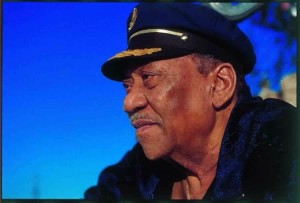 Robert Calvin “Bobby” Bland (January 27, 1930 – June 23, 2013), also known as Bobby “Blue” Bland, was an American singer of blues and soul. He was an original member of the Beale Streeters, and was sometimes referred to as the “Lion of the Blues”. Along with such artists as Sam Cooke, Ray Charles, and Junior Parker, Bland developed a sound that mixed gospel with the blues and R&B. An imitator of Frank Sinatra, he was also known as the “Sinatra of the blues”; his music was also influenced by Nat King Cole.
Robert Calvin “Bobby” Bland (January 27, 1930 – June 23, 2013), also known as Bobby “Blue” Bland, was an American singer of blues and soul. He was an original member of the Beale Streeters, and was sometimes referred to as the “Lion of the Blues”. Along with such artists as Sam Cooke, Ray Charles, and Junior Parker, Bland developed a sound that mixed gospel with the blues and R&B. An imitator of Frank Sinatra, he was also known as the “Sinatra of the blues”; his music was also influenced by Nat King Cole.
Bland was inducted into the Blues Hall of Fame in 1981, the Rock and Roll Hall of Fame in 1992, and received the Grammy Lifetime Achievement Award in 1997.
Bland was born in the small town of Rosemark, Tennessee. Later moving to Memphis with his mother, Bland started singing with local gospel groups there, including amongst others The Miniatures. Eager to expand his interests, he began frequenting the city’s famous Beale Street where he became associated with an ad hoc circle of aspiring musicians named, not unnaturally, the Beale Streeters.
Bland died on June 23, 2013 at his home in Memphis, Tennessee, after an ongoing illness. He was 83.
Read more at: http://en.wikipedia.org/wiki/Bobby_Bland
